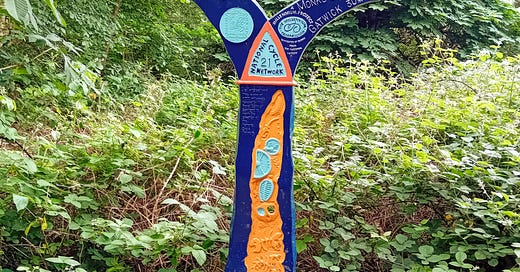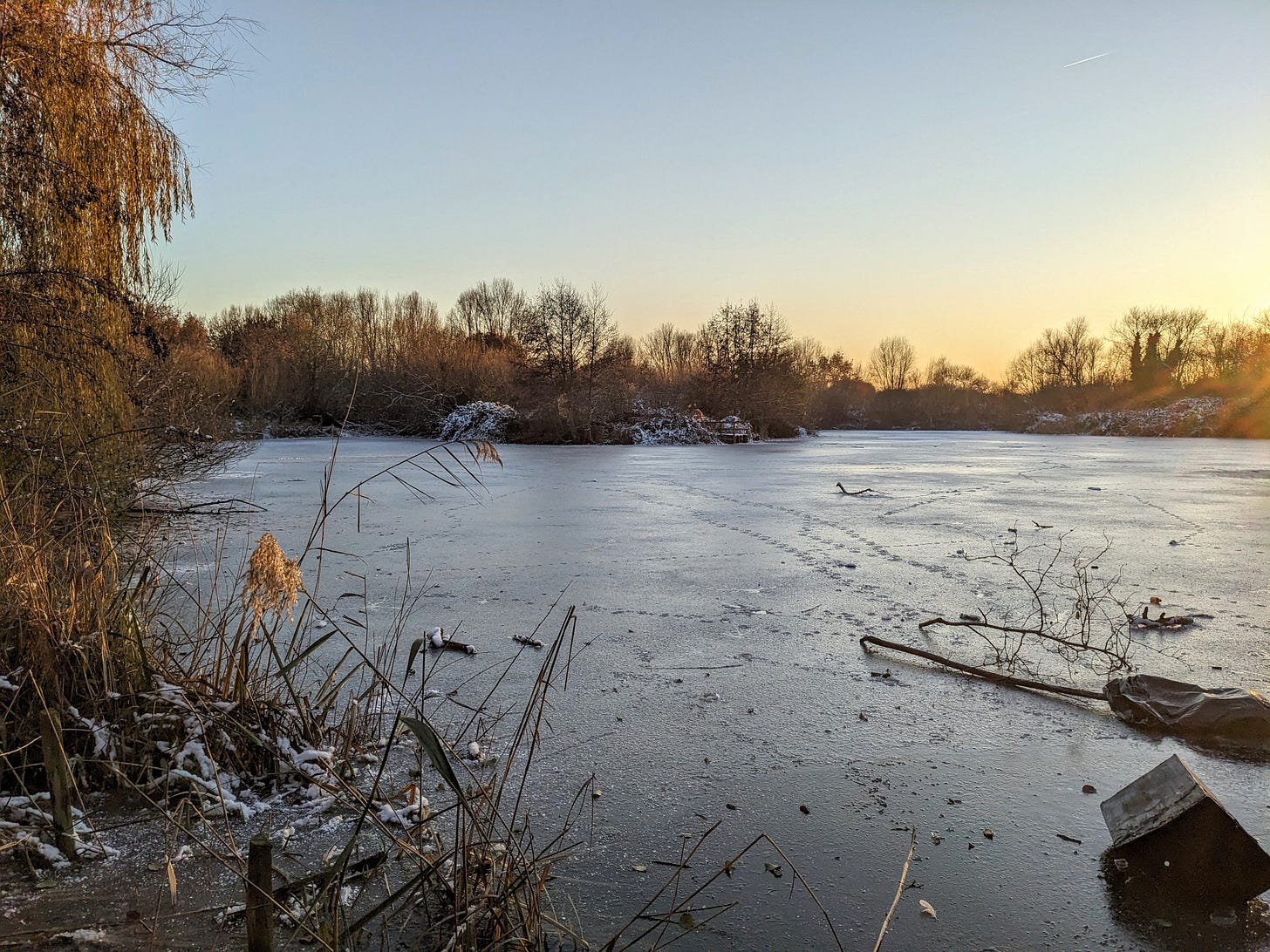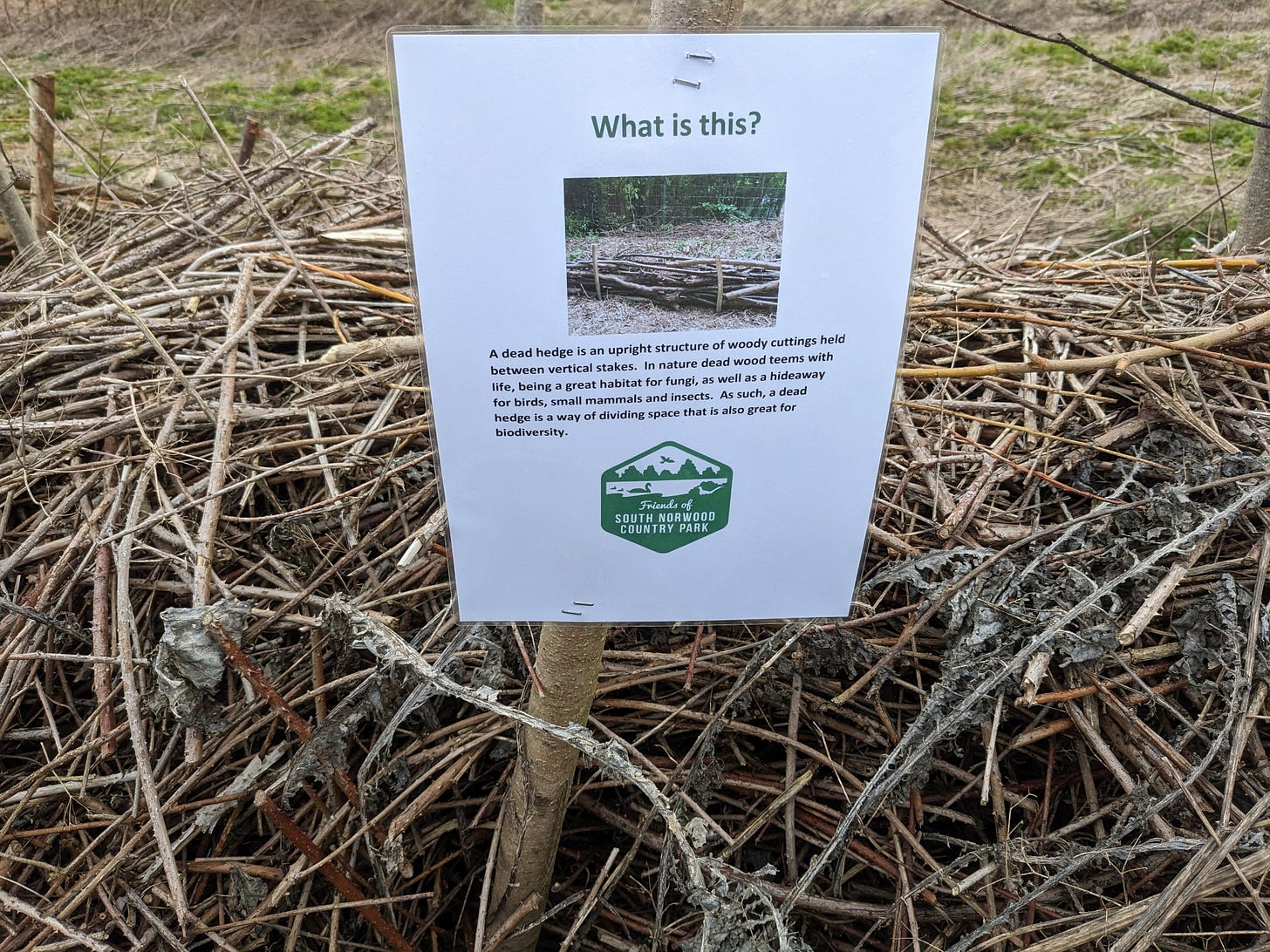I was at South Norwood Country Park with TCV* Croydon yesterday, the first time I’d volunteered here since we did the hedge-laying in February. It was good to be back even though the task we were doing – clearing vegetation along the boundary fence – involved spending most of the day next to a busy road. There was also a lot of litter to pick-up, as sadly there often is here.
Once you get away from that busy road, the 50 hectares (approx. 0.2 square miles) of the Country Park really do feel like a small patch of countryside, despite being in the middle of a heavily built-up area. This was once part of the Great North Wood and there are remnants of that ancient woodland on one side of the Park, but many of the trees were cleared to create fields centuries ago. As well as farming, the area has been used for the digging of clay to make bricks and the dumping of rubble from buildings demolished after World War 2. For around 100 years, much of the site was also used as a sewage farm. After that closed in the 1960s, natural regeneration resulted in the formation of wetlands and grasslands. Then when Croydon Council created the Country Park in the 1980s, some of the rubble was shaped into a mound and covered in grass to make a small hill and a lake was dug. As well as the wetlands and meadows, there is some more recently regenerated woodland. The resulting patchwork of habitats attracts a wide variety of different birds including species of water birds and waders such as Water Rail and Snipe that are not often seen in London, making it a popular place for birdwatching.
The Countryside Act 1968 gave local authorities the powers “to provide a country park, that is to say a park or pleasure ground to be used for that purpose” and to manage these places for public enjoyment. The idea was prompted in part by fears at the time that the countryside “proper” could be overwhelmed by visitors from towns and cities as car ownership and leisure time increased. By the time South Norwood was designated in 1987, these fears had receded, and the focus had turned to encouraging a more diverse range of visitors to enjoy rural recreational activities, something which remains a priority today. The role of country parks may now be more about providing visitors with experiences that encourage them to visit the wider countryside rather than discouraging them from visiting, but the emphasis remains on the benefits for people rather than wildlife.
In 1993, a few years after becoming a Country Park, the South Norwood site was also designated as a Local Nature Reserve. Local authorities’ ability to create nature reserves dates back to the National Parks and Access to the Countryside Act 1949 which defines a “nature reserve” as “(a) land managed solely for a conservation purpose, or (b) land managed not only for a conservation purpose but also for a recreational purpose, if the management of the land for the recreational purpose does not compromise its management for the conservation purpose”. South Norwood definitely falls into the latter of those two categories, being somewhere that is important for recreational use as well as wildlife. There are a number of other country parks which are also nature reserves but there does seem to be a slight tension between the designations. Is it always going to be possible to put the needs of wildlife first in a place where the priority is public enjoyment?
With streets of terraced houses, a train station, several tram stops and even a Tesco Superstore and a large sports arena on its perimeter, South Norwood Country Park is much visited by dog walkers, runners, cyclists and families out for a stroll as well as those just using it as a cut-through to the shops or public transport. It’s also far more accessible for those without cars than many of the older country parks which were created with car-borne visitors in mind – it even has part of the National Cycle Network running across it. But from some of our experiences while volunteering here, it would seem that many of those who visit don’t realise that this is a nature reserve. It’s not unusual for us to be asked things like “Why can’t you cut the grass in the meadows so they’re better for playing football?” or to encounter dogs running out-of-control. There have even been incidents of people removing parts of the dead hedges we’ve constructed to protect areas where birds are nesting. From time-to-time we discuss whether the problem is that the “park” bit of the current name means that people expect to use it in the same way they would any of the other local parks, as a place for picnics and kickabouts and letting the dog off the lead.
If it was called South Norwood Nature Reserve instead, would visitors have a better understanding of what the area is for? And would this provide any better protection for the birds and other wildlife who’ve made their home here? Personally, I’m not convinced that a name change alone would make enough difference. Evidence on the effectiveness of nature reserves suggests that it is not the name or the designation itself which matters, but the way in which the area is managed. For several years, until very recently, the care of the Country Park had been left almost entirely to volunteers, and even though a very active Friends group has been doing an excellent job of looking after the Park with the support of TCV Croydon, a place like this really needs someone who is paid to manage it full-time. It is great news that there is now a dedicated warden again, but it remains to be seen whether he will be given the resources needed to manage such a heavily used site in a way which allows wildlife to truly thrive here.
If we really want people to value places like the Country Park and to behave differently when they visit them, then there also needs to be a lot more funding for the kind of education and engagement activities which help people understand the importance of avoiding harm to wildlife, and to appreciate why restrictions are needed for the benefit of other species. The world has changed a lot since country parks were first conceived in the 1960s and we now know so much more than we did then about the impacts of human behaviour on other species. Perhaps rather than changing the name of this country park it is time to rethink the purposes of country parks so that there is more emphasis on the role they can all play in supporting nature recovery and in helping people understand why it is so vital to ensure other species can live alongside us.
*TCV = The Croydon Volunteers
To finish….
…a few things I’d like to share:
The Friends of South Norwood Country Park: the Friends organise conservation volunteering as well as a range of wildlife walks and other activities, including the Fungi Foray that I wrote about last Autumn. Their website also includes interesting information on the history of the Park.
Towards a Country Park Renaissance: I came across this 2003 report while trying to find out more about the establishment of country parks, and some of the information I’ve included above is based on Appendix 1 on the history and development of country parks.
Wildlife courses in Greenwich Park: The Field Studies Council are running some really interesting sounding introductory courses in Greenwich Park over the next few weeks, covering bees, earthworms, wildflowers and more. At £15 for 3 hours they’re great value too so I’m disappointed I can’t make any of the dates but hopefully they’ll do something similar again in future.






